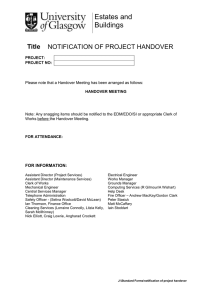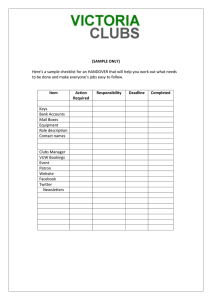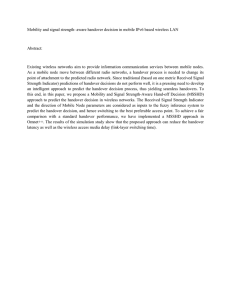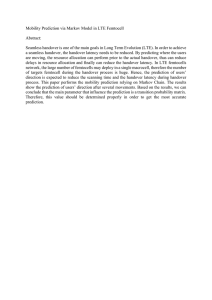Generic MAC Layer Handover Procedures
advertisement
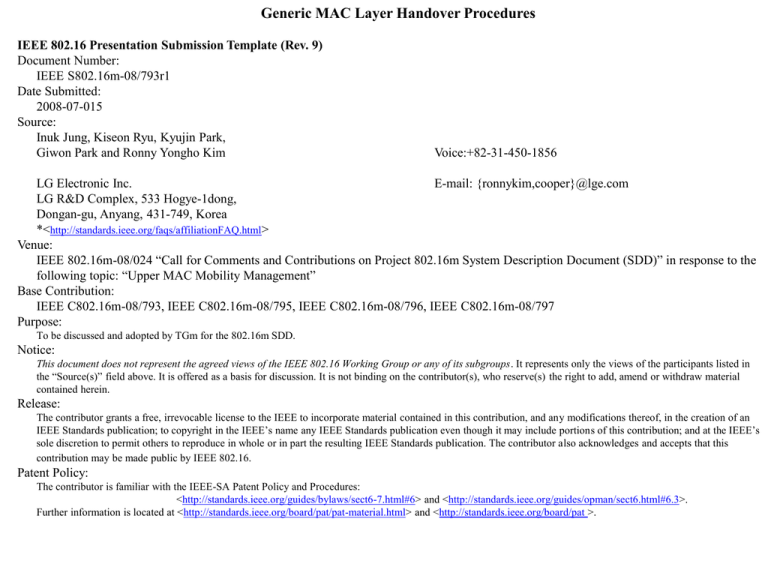
Generic MAC Layer Handover Procedures
IEEE 802.16 Presentation Submission Template (Rev. 9)
Document Number:
IEEE S802.16m-08/793r1
Date Submitted:
2008-07-015
Source:
Inuk Jung, Kiseon Ryu, Kyujin Park,
Giwon Park and Ronny Yongho Kim
Voice:+82-31-450-1856
LG Electronic Inc.
E-mail: {ronnykim,cooper}@lge.com
LG R&D Complex, 533 Hogye-1dong,
Dongan-gu, Anyang, 431-749, Korea
*<http://standards.ieee.org/faqs/affiliationFAQ.html>
Venue:
IEEE 802.16m-08/024 “Call for Comments and Contributions on Project 802.16m System Description Document (SDD)” in response to the
following topic: “Upper MAC Mobility Management”
Base Contribution:
IEEE C802.16m-08/793, IEEE C802.16m-08/795, IEEE C802.16m-08/796, IEEE C802.16m-08/797
Purpose:
To be discussed and adopted by TGm for the 802.16m SDD.
Notice:
This document does not represent the agreed views of the IEEE 802.16 Working Group or any of its subgroups. It represents only the views of the participants listed in
the “Source(s)” field above. It is offered as a basis for discussion. It is not binding on the contributor(s), who reserve(s) the right to add, amend or withdraw material
contained herein.
Release:
The contributor grants a free, irrevocable license to the IEEE to incorporate material contained in this contribution, and any modifications thereof, in the creation of an
IEEE Standards publication; to copyright in the IEEE’s name any IEEE Standards publication even though it may include portions of this contribution; and at the IEEE’s
sole discretion to permit others to reproduce in whole or in part the resulting IEEE Standards publication. The contributor also acknowledges and accepts that this
contribution may be made public by IEEE 802.16.
Patent Policy:
The contributor is familiar with the IEEE-SA Patent Policy and Procedures:
<http://standards.ieee.org/guides/bylaws/sect6-7.html#6> and <http://standards.ieee.org/guides/opman/sect6.html#6.3>.
Further information is located at <http://standards.ieee.org/board/pat/pat-material.html> and <http://standards.ieee.org/board/pat >.
Objective
• In order to satisfy the SRD based on mobility
measures (hard handover latency<=30ms) and to
enhance possible handover related issues overall, the
MAC layer handover procedures need to be revised.
• The following issues, at least, should be considered
for improving handover procedures, since every issue
are related to and have influence on handover latency
–
–
–
–
Signaling procedures (direct latency improvement)
Reliability (e.g. handover failure management)
Overhead
Inter-RAT Handover
MAC Layer Handover Focus Areas
• Traditional functions:
– Signaling procedures
• Handover preparation signals
• Handover execution signals
– Fast Ranging
– Reliability
• None (handover failure recovery provided only through retransmission)
– Overhead
• None
– Inter-RAT Handover
• None
• Enhancement features:
–
–
–
–
Authenticated Handover signaling (C802.16m-08/795)
Dedicated Handover procedure (C802.16m-08/797)
Superframe alignment considered handover initiation (C802.16m-08/796)
Inter-RAT Handover procedure (C802.16m-08/793)
Handover Initiation
• Superframe aligned Handover procedure
– Problem definition: due to frequent change of System Information
(PBCH, SBCH), MS may experience higher handover latency
– Objective: provide a scheme of handover initiation that prevents any
extra latency requirement for updating SI attributes during handover
execution.
MS
SBS
MS
TBS 1,2,3
Serving BS
Target BS
HO request…
HO_REQ
(SI bitmap for each NBS)
HO_REQ
HO_RSP
HO_RSP
(send λSI for each NBS,
BDP, etc)
MOB_HO-IND
(slected TBS 3)
BS switching
time
HO-IND message
to TBS 3
Synchronize to DL
Fast_RNG_IE
Action
time
RNG_REQ
RNG_RSP
Check for SI
mismatch (if
mismatch
detected, transmit
mismatching
parameters)
MS’s
PBCH/SBCH
context of TBS
Attribute
Value
Attribute
Value
A
1
A
1
B
2
B
3
C
4
C
4
D
3
D
1
E
3
E
3
Attribute
Value
Attribute
Value
A
1
B
3
B
3
D
1
C
4
D
1
E
3
Check mismatching PBCH/SBCH attributes
Transmit mismatching PBCH/SBCH attributes, {B,D}
BS Disconnection
Point (BDP)
TBS’s current
PBCH/SBCH
context
Handover Execution signaling (1)
• Handover Execution phase:
– 1) Dedicated handover execution
– 2) Authenticated handover ranging
1) Dedicated Handover execution
Target BS
(selected by
MS)
Serving BS
MS
MOB_MSHO-REQ
HO request
– Problem definition:
– Objective:
• provide CDMA code dedicated
handover execution scheme for safe
and low overhead handover.
MOB_HO-IND
HO confirm
HO interruption time
• UL resource dedication for every
candidate BS is expensive (through
MOB_BSHO-RSP in 16e).
• The CDMA code itself is not
dedicated giving possibility of code
collision which will incur higher
handover latency
HO response
MOB_BSHO-RSP
UL-MAP (Ranging channel allocation,
Dedicated ranging code allocation)
Dedicated ranging code
RNG-RSP (UL sync. infor. & Temporary
CID alloc.)
RNG-REQ
RNG-RSP (HO Proc. Opt. & CID Alloc. &
CQICH Alloc.)
CQI & BR header
Date transfer
Candidate Target
BSs (not selected)
Handover Execution signaling (2)
2) Authenticated handover
ranging
• Problem definition:
• Objective:
– The lower HO interruption time by
combining CDMA code ranging
and message ranging during HO.
Target
BS
MOB_MSHO-REQ
HO request
HO response
MOB_BSHO-RSP
MOB_HO-IND
UL grant for ranging code transmission
(M=f(AK, CMAC-key count, DCI)
HO interruption time
– Message based handover ranging
has the low probability for a target
BS to successfully decode the
ranging request message, which
can increase the handover latency.
– CDMA HO ranging basically has a
long latency due to much of
signaling (i.e. CDMA code ranging
and message ranging) between
target BS and MS.
Serving
BS
MS
Ranging Code (DCI)
RNG-RSP for code (Timing/Power
Adjust, HO Proc. Opt. & CQICH
allocation, etc.))
Date transfer
Inter-RAT Handover Procedure
Three Handover phases:
- HO Preparation
- HO Execution
- HO Completion
1) Handover Preparation
• Network discovery and Network Selection (NDNS)
• Pre-registration with Candidate BSs
2) Handover Execution
• HO related control signal exchange and context transfer
• Radio switch to Target BS
3) Handover Completion
• Completing handover session (redirection, MS resource release etc)
Inter-RAT HO Preparation
...
• Network Discovery and
Network Selection (NDNS)
– Acquire network topology of
other RAT systems for possible
HO candidates
16m BS
MS
Target
Access
ASN-GW
User DL/UL Data
1. Network Topology
Acquisition
2. MS triggers other
RAT scanning
3. Scanning
Request/Response
4. Discovering the network
supporting the pre-registration
capability & Scanning
• Pre-registration with Target
BS
– Pre-registers to target BS for fast
HO execution and fast recovery
from radio link failure
...
16m BS
MS
ASN-GW
User DL/UL Data
1. Decision to pre-register
to other RAT
2. Pre-Authentication
3. Pre-Registration
Target
Access
Inter-RAT HO Execution & Completion
16m BS
MS
• HO Execution
– HO related control signal
exchange and context
transfer
ASN-GW
Target
Access
User DL/UL Data
1. Decision to HO to
other RAT
2. HO-REQ
(pre-registered BS)
HO-REQ
HO-RSP
• HO Completion
– Resource release of MS
and switching to other
RAT
2. HO-RSP
(pre-registered BS)
HO execution
2. HO-IND
(pre-registered BS)
DL Data Forwarding
3. Bufer packets
from Serving BS
4. switch to the other
RAT radio
5. Access to the target RAT BS
6. Release MS
Resource
User DL/UL Data
HO completion
